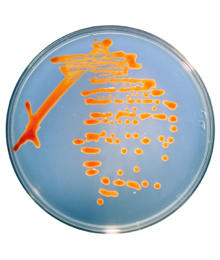An interview with Vicky Smith
August 2020
Vicky Smith is a PhD student at the University of Nottingham, UK. In this interview, she tells us more about her PhD project which focuses on the DNA replication of halophile Haloferax volcanii.

Tell us more about your current research.
Archaea were first defined as their own domain of life, alongside bacteria and eukaryotes, in the 1970s following Carl Woese’s pioneering work on 16S ribosomal RNA (rRNA). Since then, the development of genetic, sequencing and biochemical techniques has allowed scientists to investigate numerous archaeal species in more detail.
My PhD project focuses on DNA replication in salt-loving halophile Haloferax volcanii. While archaea may look like bacteria when streaked on an agar plate, comparison of the proteins used for the fundamental processes of DNA replication and repair reveal bacteria use a completely different system to archaea. Remarkably, the archaeal DNA replication machinery in fact shares similarity with that found within our own cells. Most archaeal replication proteins were in fact identified as homologues of known eukaryotic replication proteins. The obvious likeness between archaea and eukaryotes, and dissimilarity with bacteria, suggests a common ancestor for archaea and eukaryotes separate to bacteria: recent genomic studies are now suggesting archaeal species were in fact the direct ancestor of all living eukaryotes. This similarity with eukaryotic machinery (including that found in humans) allows us to study archaea as a simplified and more primitive model of complex eukaryotic replication. Using this we can pick apart the machinery, work out why we carry the proteins we do and pick apart whether they share their roles from archaea to eukaryotes.

Why is understanding archaea important to microbiology?
Over the years, archaeal replication enzymes have been a hot topic; thermophilic archaeal polymerases are now commonplace in all genetics labs, being used as standard thermostable polymerase chain reaction (PCR) enzymes. Now, we aim to not just understand not only what the enzymes are able to do but want to use the genetic and biophysical tools available to understand the multi-protein complexes as well as in vivo characterisation of DNA replication processes. Ongoing work is discovering previously unknown archaeal species in more and more extreme niche environments, providing scope for seeing how archaeal replication systems alter when exposed to different environmental challenges, as well as allowing a more thorough mapping of the tree of life.


